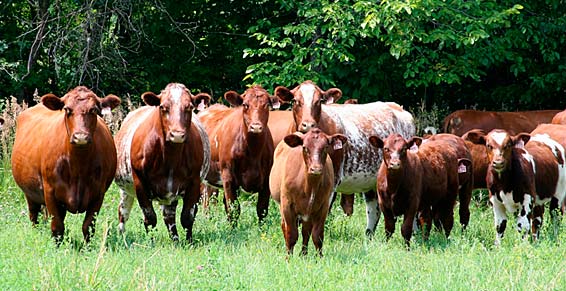Shorthorn Genetics
Davis Rairdan has Shorthorn embryos for sale from some of the most distinguished bloodlines in Canada. Shorthorn cattle are making a comeback among cattle ranchers, after dropping off in popularity a few years ago. Shorthorn cows are very maternal with very few problems in calving and very seldom reject newborn calves. Shorthorn feeder cattle are very feed-efficient and reach market weight quickly, thereby saving feed costs and boosting the bottom line.
The maternal value of these genetics, have always been a strong trait and will continue to be. The female, purebred or crossbred has long been sought after for it's early maturity, fertility, ease of calving, milk production, longevity and lets not forget docility. Take your pick of the traits you require and these genetics can adapt to your situation.
In the area of performance the breed takes a back seat to no one in the overall picture. While the average daily gain is usually average or slightly above, feedlot operators quickly determine that crossbred feeders excel in the areas of feed conversion and cost per pound of gain. Recent large scale tests results in Alberta and British Columbia only magnify these traits in comparison to other breeds and crosses.
Carcass traits in the past have been an area where the exotic or terminal breeds have excelled. However with the more recent return and focus on a moderate carcass with consistent superior marbling, the carcass traits of this breed have become more popular. Feedlot tests reveal that Shorthorn influence cattle reach the optimum carcass weight at an earlier age with a higher percentage of AA + marbling. While exotic breeds will claim more muscling and larger rib-eyes they cannot compete with the consistent, well marbled, high yielding Shorthorn carcasses.
Canadian Shorthorn Breeders
Early Canadians preferred Shorthorns - the pioneers called them the universal breed. They liked the big framed red, or roan, or white cattle for dairy products, food and working oxen.
Canada's first imported cattle were likely Shorthorns. Incoming settlers looked to England and Scotland for seed stock. When the first Canada Herd Book was published in 1867, shorthorns were included. The breed traces animals back to as early as 1825 in North America.
The demand in Canada for excellence in the breed saw many animals imported over many years from notably Scotland. Eventually two distinct types of Shorthorns were developed - those with beef characteristics and those with strong dairy qualities.
History of Shorthorn Cattle
About 225 years ago in Durham County in North East England, the Shorthorn breed had its founding. Achievers - strong calibre people who had gained notoriety in areas of agriculture, public service, politics and industry, created the breed.
A Mr. Colling selected a bull at a sale and mated him with his brothers newly acquired expensive cow - "Dutchess". The progeny were the basis of a new breed with desirable traits - larger frames, powerful and docile oxen. They were claimed to be of superior mothering qualities and produced above average quantities of milk.
As the breed matured there in the Valley of the Tees, emphasis was placed on improving the traits. As the reputation of the cattle spread, Scotland was the destination of some animals. With vigilance on up-grading the breed, exports occurred to other countries.
Scotland's chief exports became Scotch Whiskey, Clydesdale horses and Shorthorn Cattle. From the Valley of the Tees unfolded a breed useful for big frames, beefy and a natural capacity for fast and efficient conversion of feed to food. Combined with docility, the breed was unequalled.
By selecting beef cattle that were good milkers and milk cattle that were efficient producers, the breed made a huge impact on the international scene.

